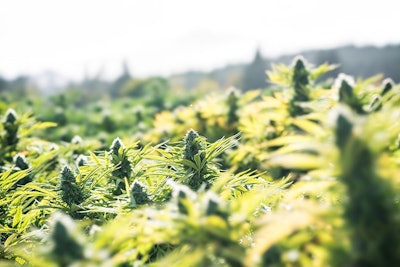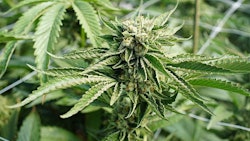
While the 2018 Farm Bill’s legalization of industrial hemp will allow more farmers to take advantage of this new crop, no pesticides are federally approved for use on the plant.
In a paper published in Crop Protection, Purdue University researchers Janna Beckerman, Leah Sandler, Fred Whitford and Kevin Gibson outline some of the problems surrounding the lack of approved pesticides for hemp and cannabis. They also call for a clear federal framework to define pesticide rules, research funding to help uncover valuable information for cultivators, and policies and procedures to ensure the safety of products derived from the plants.
Here, Beckerman, a professor of botany and plant pathology, and Whitford, director of Purdue Pesticide Programs, describe the problems hemp and cannabis growers face due to the lack of pesticide regulations, as well as how these problems may be resolved through clear federal guidance.
Cannabis Business Times: Can you describe some of the problems that the lack of federal pesticide regulations presents to hemp and cannabis growers?
Beckerman: We already knew [pesticide questions were coming] from [cannabis] companies, whether it was growing it for hemp or for marijuana. I was getting contacted: “I have this problem.” Some people were like, “Look, I’m growing this…umm…plant, and this is what I think my problem is. What can I spray?” Or, “I’ve tried what I’m allowed to spray, and it’s not working.” A lot of states weren’t even allowing extensions to discuss this with people who called because they were afraid of losing their federal funding. People would say, for example, “I’m having a problem with powdery mildew,” and they would look up one of my bulletins, and it would say in the greenhouse for zinnias, you can spray Heritage or Pageant, you can spray myclobutanil, you can spray chlorothalonil, and they would take that information and then apply it to marijuana or even just cannabis for CBD; but nobody is smoking zinnias, so the safety hasn’t been established for those uses.
In California, Colorado, Washington and Oregon, they’re testing samples of marijuana or cannabis for CBD and they’re finding pesticides that are not legal to use, and in some instances, they’re finding them in levels that are 100 to 1,000 times more than what would be legally acceptable in commensurate crops.
Whitford: From my perspective, there are numerous problems. One is that the people who grow cannabis are not our clientele. We don’t see them [and] we don’t meet with them, as a rule. More importantly, as extension people, we’re not in front of them, telling them the things that a normal farmer would understand. So, it’s a lack of information about products, pesticides, testing, legal use [and] illegal use. We don’t have that outreach to those people.
If you’re going to treat them as farmers, then they should have the same educational opportunities as any other farmer. You have a whole group of people who are out there and confronted with a number of production problems they face that every other farmer faces, but with very little research on [them], these men and women are left to their own wits to figure out how to best do things.
Because they’ve never had the opportunity to learn some of these facts, [they don’t know] that just because a product works, let’s say, to control the insect, weed or disease on another crop, [that] doesn’t give you permission to use it on cannabis, and that has to do with levels of residues. How quick [do] these chemicals break down, if they break down? How much is left in the final product? We have, on the food side, tolerances. These are what the [pesticide] manufacturers have to shoot for, and the growers that apply them to their products. So, we don’t really have any tolerances, and we don’t have any testing done. What happens is, out of desperation [to combat] insects, weeds and diseases, our cannabis growers are using products, and since none of them are registered [for use on cannabis], they’re going to be using products that are labeled for other products, where the testing hasn’t been done on residues.
CBT: What options do hemp and cannabis cultivators currently have for pest management, since pesticides are largely unregulated?
Beckerman: [Some products] are [allowed for use on cannabis], according to [the] Colorado [Department of Agriculture], and these products are generally regarded as safe, but there’s lots of data to show that they’re not as effective as conventional fungicides and that they require a lot more applications.
CBT: What research needs to be performed on cannabis as it relates to pesticide use and safety?
Beckerman: There’s a lot of research that has to be done, and the process for getting this done isn’t entirely clear to me, quite honestly. The chemical companies that I’ve worked with are very leery about going into this because of the risk of litigation. They’re going to be very careful because of the possibilities of misuse and making sure that even when it is used, that it is safe for the end users. What ends up being considered acceptable and safe for growing hemp as a fiber crop is not going to be the same as what’s considered safe for growing marijuana to concentrate the THC to use in edibles, for example. Those are very different end uses. You’ll use Product A to spray for hemp for control of a foliar problem. If you were to spray that same product on marijuana, say, in a greenhouse, and you concentrated that and that was put into an edible, that pesticide is then carried and concentrated along with the THC or the CBD.
The next issue would be, if one state allows something to be used, can that be sold across state lines? Because pesticides are regulated federally, but states have their own rules. This is probably the only crop in U.S. history (since the Land Grant act) that hasn't benefitted from the Cooperative Extension Service, and it shows in the poor information available for growers and the predatory vendors taking advantage of that. Not having the [United States Environmental Protection Agency (EPA)] and [United Stated Department of Agriculture (USDA)] involved in regulation is another problem. In some states, I’ve been told that growing facilities are being regulated and inspected by the local and state agencies that are trained at inspecting food caterers and restaurants.
Whitford: Places like Ohio State, University of Illinois, Purdue, Michigan State—we’re called land grant universities, or some would call [us] ag engineering schools. Here, we have a large ag program, and we have people involved in research, teaching and extension. That same sort of network needs to be set up for the people raising this new crop. If you’re going to view it as a crop, then they need to have the same sorts of advantages that all of our other farmers have. If there’s no interest at the university, where are they going to get their information?
CBT: What is the process like for pesticide manufacturers to prove the safety and efficacy of their products, and for those products to be approved for use on certain crops? Could this process eventually translate into the cannabis industry?
Beckerman: That goes [back] to the issue of pesticide regulation and how they end up classifying cannabis [in the Controlled Substances Act]. Because it’s going to have multiple classifications, the process is probably going to be different for those classifications.
Oftentimes, the chemical company has a new product that they want to test on some specialty crop. So, I get this numbered product, and we actually test it against a set of pathogens that they think it will work in controlling. We do these experiments, and there are people all over the country repeating these experiments to make sure that it actually works the way they say it does.
From there, they take literally boxes of data, and those boxes of data are sent over to the EPA to not only show that the product works, but to show that it has minimal risk. And then they go through an evaluation period where they listen to different constituency groups, and some groups may say, “We have data saying it’s a carcinogen.” And another side will say, “No, that data is flawed,” and it goes back and forth. And it does take many years, and generally for any new pesticides that come to market, it [costs] about $250 million.
Cannabis, though, is very different because the products are already developed—it’s going back and seeing if they can be safely used, and then at what level they’re going to be used.
Whitford: Whether the pesticide manufacturers are going to provide products [for cannabis] probably would depend on two things—the size of the market and whether their stockholders feel comfortable with them being in this market.
Currently, it [takes] almost 10 years’ worth of research and review by the EPA to get a product through the EPA. In pesticides, the patent is only good for 17 years. So, it is extremely [expensive] and extremely long to get something that we call the EPA registration number.
Those tests are done based on EPA protocols. They’re going to look at the chemicals, how much residue is left and what do those levels represent, relative to human health? They do the cancer studies, the short-term studies, the birth defect studies—all those kinds of studies.
Then, the other half has to do with [the question], “If I make the applications to cannabis, how is it going to [affect] the environment?” So, they’ll look at water runoff, ground water studies [and] the impact of that chemical on wildlife.
CBT: Can you describe the federal framework for defining pesticide rules for cannabis that was outlined in the paper? What policies and procedures are needed to ensure product safety in the cannabis industry?
Beckerman: There is a framework for other products, and they’re going to have to figure out how to best substitute that framework [for] cannabis—keeping in mind that there are different purposes and making sure that the end use is clarified for those purposes—and then to also make sure that the penalties in place are significant if the label is violated. We always say that the label is the law, and the punishment can be up to a year in jail and a $25,000 fine if it’s violated. Originally, the EPA would say that they couldn’t label any pesticide because cannabis was a Schedule I, and now that’s not the case [with hemp], [so] they can label pesticides for [use on] hemp.
Whitford: First of all, the EPA will have to make a decision now that Congress is making some changes. Will they allow the registration of pesticide products on certain uses?
If that’s allowed, then the industry next will have to decide, are [manufacturers] going to register products for those uses—based on acres and cost? Once those products are registered, then people like the universities will have the ability to test those products, evaluate those products and communicate the results to the cannabis growers. That’s where we will say things like when to use it, how much to use, when not to use it, stay away [from it] when you’re getting near harvest. That generally opens up the discussion about production and how to best grow it. Our researchers here, like Janna, then begins to have her plots to determine when to treat, but also how to grow these things—where it’s efficient, effective and we produce the most at the highest quality.
CBT: Do you think pesticide regulations for hemp are likely to unfold with the passage of the Farm Bill? What is your overall outlook on pesticide use in the cannabis space?
Beckerman: My concern is that people are going to be growing this and investing a lot of money, and they’re not going to have the tools—and by tools, I mean pesticides—to protect their crop. My advice is to wait a year and start planning. Get that plan in place and include in that plan how you are going to manage pests. There are products available that they call the Federal Insecticide, Fungicide and Rodenticide Act (FIFRA) 25b, and I refer to them as the Thai cooking class of fungicides because it’s chili oil, garlic oil, pepper oil—things like that. Herbs. They’re modestly effective, at best, and require a lot of applications. For large growers, they’re probably not economically feasible.
Whitford: Government moves so slow. Would I be looking for anything immediate? Well, probably not because once government makes that decision [to allow pesticides to be registered for use on hemp], they have to put the rules in place. They have to make policy decisions. Then, the lag here will be the manufacturers. What will help the industry is if the manufacturers already have the [active ingredient] registered. That will speed things up immensely because then they would’ve already had a lot of these long-term studies that may take three, four years to complete. So, it probably will be left up to how quick the federal policies change, and then where the states would then position themselves around those policies.
For me, the conclusion is, if you’re going to treat this like a crop, then it needs to be supported like every other crop. If we’re going to allow it to be grown, then we need to help our farmers who grow it to do the best they can and to make a living doing this.
Editor’s Note: This interview has been edited for length, style and clarity.
























